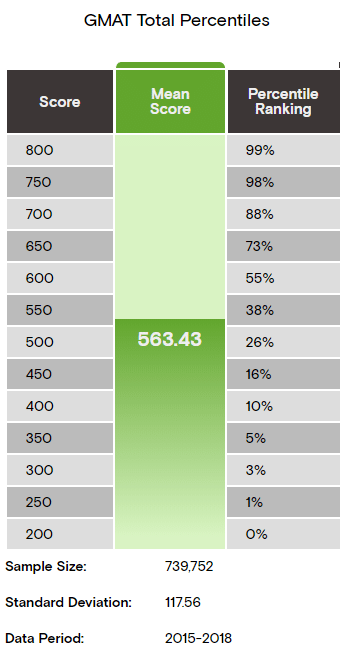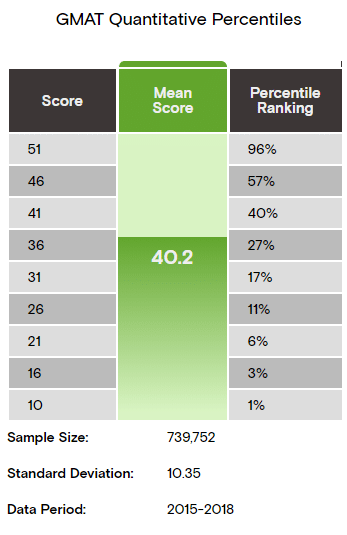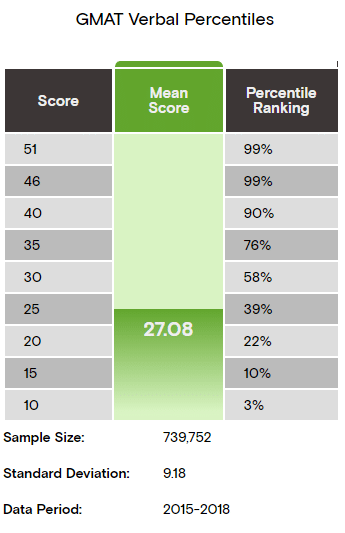 GMAT stands for the Graduate Management Admissions Test; this is a widely-used standardized exam developed by the GMAC, or Graduate Management Admissions Council. The purpose of the GMAT is to measure your skills and to predict whether you will be successful as a student pursuing your MBA, a designation that has gained prestige and become more inclusive over the past decade. Over 6,000 programs worldwide use this test as part of their admission process, so any aspiring business professional will benefit from getting to know the structure, difficulty level, and scoring of the GMAT exam.
GMAT stands for the Graduate Management Admissions Test; this is a widely-used standardized exam developed by the GMAC, or Graduate Management Admissions Council. The purpose of the GMAT is to measure your skills and to predict whether you will be successful as a student pursuing your MBA, a designation that has gained prestige and become more inclusive over the past decade. Over 6,000 programs worldwide use this test as part of their admission process, so any aspiring business professional will benefit from getting to know the structure, difficulty level, and scoring of the GMAT exam.
How Is The GMAT Scored?
First, the basics. Before we get into interpreting your potential scores for the exam, we have to understand how the GMAT works in general. There are four sections of the GMAT, which each have a unique score and a specific scoring increment:
- Quantitative Reasoning (QR), 62 minutes
- Verbal Reasoning (VR), 65 minutes
- Integrated Reasoning (IR), 30 minutes
- Analytical Writing Assessment (AWA), 30 minutes
In all, these sections add up to make the duration of the GMAT 3.5 hours long. Adding up the scores, though, is a different story. The scores from four sections don’t add up together to form your total exam score. Instead, the GMAT’s total score is determined by adding only the Quantitative Reasoning (QR) and Verbal Reasoning (VR) sections of the exam, and the Analytical Writing Assessment (AWA) and Integrated Reasoning (IR) scores are given separately.
Some schools weigh these different sections uniquely, so the AWA section score may be more important in their decision than the QR score, for instance. So, if you’re trying to get into your dream school, it’s not only important to know the average GMAT scores of accepted applicants, but also the different weights your school applies to each section.
GMAT Score Table
| Section | Score |
| Overall test | 200-800 points, 10-point increments |
| Quantitative Reasoning | 6-51 points, 1-point increments |
| Verbal Reasoning | 6-51 points, 1-point increments |
| Integrated Reasoning | 1-8 points, 1-point increments |
| Analytical Writing Assessment | 0-6 points, 0.5 point increments |
What Is a Good GMAT Score?
When I taught a GMAT prep course, almost everyone began the course saying their goal was to get above 700 points on the test. While this is a great goal, getting a 700 on the GMAT is difficult, potentially unrealistic, and often completely unnecessary!
Many excellent programs have average GMAT scores in the mid 600s. However, unless the rest of your application is truly exceptional, you’ll probably need to score higher than 700 on your GMAT to get into the MBA programs at schools like Harvard, Wharton, and Stanford. Most applicants accepted into top-ranked MBA programs scored well above 700 on the GMAT.
According to US News and World Report, for the fall 2018 incoming students of the 128 ranked business schools, their average score was 625. The top 10 schools with the highest GMAT scores had an average score of 729. Columbia had the highest average GMAT score at 736. On the other side of the spectrum, those schools with the lowest scores had an average of 483. The average score for all GMAT test takers was 561.
These scores can seem pretty intimidating at face value, so it’s important to remember:
Realistically, crushing the GMAT doesn’t always mean scoring above 700. A good GMAT score depends on your school of your choice, but ideally a good GMAT score should be at least in the mid 600s.
Here, we’ll examine what it takes to get a good GMAT score, including interpreting school’s GMAT requirements, aligning yourself with a specific GMAT passing score goal, evaluating your GMAT score results, and finally, the steps needed to improve your score throughout the test-taking process.
8 Steps to Getting a Good GMAT Score
The GMAT is one of the most important pieces of any MBA admissions package. Every school has a different standard for determining what score is a good GMAT score, and places a different weight on the scores of potential students. If you want a competitive MBA application, you can’t just fly into things unprepared. Determine your target GMAT score based on your goals, take the time and energy to prepare for the exam, and put together a well-rounded and competitive application. These steps, without a doubt, give you the best chance for success in getting into business school.
Research which schools you’d like to attend
This is the first step in determining your GMAT game plan. Once you’ve decided on a few schools, you should research their application requirements and GMAT ranges. There is no one good GMAT score, and each school will have a different range of what is competitive.
Determine your target GMAT score
Once you’ve determined your schools of choice and researched their application requirements and GMAT averages, you can determine your target score, the score that makes you competitive in a sea of other applicants. This number is based on the school’s averages and priorities, as well as the rest of your application. In order to be competitive, you should probably aim for a score that is at or above your chosen school’s average.
Take a practice test
Once you know what your target score is, it certainly won’t hurt to take a practice test. This will help you figure out what needs to be done to get to your target GMAT score and how long it might take. It can also help you determine, early on, whether the GMAT is right for you; perhaps a test like the GRE might be a better option than the GMAT.
Register for the GMAT test
Once you know what you’re aiming for, register for the test. When you schedule the date you’ll take the GMAT exam, plan for the worst-case scenario. Between your GMAT exam and your application deadlines, give yourself enough time to retake the GMAT in case you want to improve your results. Also, give yourself plenty of time to prepare before the test itself. Depending on how long you’ve been out of school, as well as your personal studying and test-taking skills, you may need more or less time to study. For recent graduates, this may only be a month or two. For those that have been out of school for longer and need a simple refresher on some business basics, 6 months may be the right amount of time. Avoid registering for the GMAT over 6 months in advance, as this allows most students to procrastinate until the last couple months, instead of maximizing their GMAT prep time.
Prepare for the GMAT exam
Diligent preparation can improve your score dramatically, and cannot be underestimated. Determine a game plan early on, and stick with it. Keep your target score in mind, as well as the priorities of your chosen school. Most importantly, strengthen your weaknesses. Most students will benefit from a GMAT test prep course to help stay on track and learn helpful insights from a GMAT expert. Take a look at our reviews of GMAT prep courses to determine whether that’s the best option for you, and to find one that fits your lifestyle, budget, and learning needs.
Take the GMAT
The exam is held at one of over 600 official test centers throughout the world. Once you’re there, just eliminate distractions, have a positive attitude, be confident in your preparation and abilities, and crush the test.
Evaluate your score
You will receive your unofficial score immediately through the test center. At this point, you can evaluate your score and determine your application game plan. Did you reach or beat your target GMAT score? Great! Start the application process. Didn’t do as well as you hoped? Then take a look at step 8:
Improve your GMAT score
If you did not do as well as you hoped on the GMAT, it’s not the end of the world. Now is the time to re-evaluate your application plan, find new ways to prepare, and retake the test. Good GMAT prep courses can point you in the right direction and give your GMAT score the boost it needs, but no matter how you prepare this time around, don’t let your previous experiences get you down.
Setting a Target GMAT Score
What Are Average GMAT Scores?
As we said before, the first step to getting a good GMAT score is setting a target for yourself, which only has to satisfy your personal academic and professional goals. To find out what score you need on the GMAT, you’ll have to do a little research based on your abilities and aspirations. Depending on the schools you’re applying to and the career you want to pursue, a good GMAT score is anywhere from the high 500s to the mid-to-high 700s.
To put it plainly, if you want to get into a top-ten business program, you’ll likely need to score above 720 on the GMAT. If you are looking at mid-range business schools, you can reasonably aim for the mid-to-high 600s.
You can often base your goal on the average GMAT score for your school of choice, or the average score range for your school; a school’s average score range is generally the range of scores that 80% of their incoming students received. This means that even if you score at the bottom of that range, you could still have a competitive application because 10% of incoming students will have scored below you.
Most schools publish the GMAT score averages for their students right after the incoming class has been accepted and enrolled. Keep up to date with the websites of the schools you’re reaching for so that you can immediately take steps to reach your GMAT goals .
It is important to keep in mind that the published average GMAT scores are not the minimum scores, they are the average, so there are plenty of students that scored higher or and lower than that number. If the average score for your dream business program seems inches out of reach, don’t worry! It’s not a hard and fast requirement, and there are plenty of resources available to help you get there. Application consultants or test courses can provide professional guidance during the application process. If you’re interested, we’ve put together a list of the Best GMAT Prep Courses that can take your GMAT studying to the next level.
If your schools of choice do not publish their average GMAT scores themselves, take a look at the US News and World Report business school rankings, or search through GMAT forums to get an idea. Beyond that, you can also find out everything you need to know about your school’s GMAT requirements by calling their admissions office (plus, calls like that also might help you strike up a more personal relationship with the admissions office, so it’s hardly ever a bad idea).
Don’t forget—in addition to your chosen school’s average, consider the weights your school applies to each section of the GMAT and what they look for in the rest of your application when determining your target score.
Once you’ve found the averages you’re looking for, set a target at or above that number and use it to prepare for the exam. If you take a practice test early on in your preparation, you can determine what you need to do to reach that number.
GMAT Scores and Applications
As we’ve mentioned before, individual schools will also look at and weigh the parts of the GMAT differently. Some schools will prioritize your AWA score, while others may only look at your QR and VR scores. Even then, some schools will place less emphasis on the GMAT than on the other aspects of your application; this is especially true for part-time and professional MBA programs. This is just another reason to take a closer look at the individual programs you’re interested in before determining what a ‘good’ score for you is.
Once you find the average GMAT score for your school of choice, you can easily aim to reach that number, or even shoot for a score a little bit above that average. Still, once you have that number in mind, you have to consider the rest of your application package and how you present yourself there. If you feel very confident about your application package, there’s a chance that your GMAT score can be closer to the average accepted score for your school, rather than higher. A great business school application could include a very high undergrad GPA, an impressive resume and letters of recommendation, and meaningful extracurricular activities. With an application like that, you may be able to get away with a lower GMAT score. If not, you may have to work a little harder on your GMAT to stand out from the competition.
What Are GMAT Minimum Scores?
As you research your dream business program, you have to keep tabs on their average GMAT score, but their minimum GMAT score is often just as important. Most programs will not even review your application if you score below this number on the GMAT, no matter how exceptional the rest of your application is. Finding out the minimum GMAT score for your ideal school is usually not as simple as finding the average, but a quick call to the admissions office may get you the answer.
It’s important to remember that the lowest acceptable score is usually nowhere near the average GMAT score, so, depending on your abilities, it’s not the best goal you can set for the GMAT. That’s simply because the minimum score doesn’t make you competitive—it’s just the score that will get the admissions officer to review your application. Unless there is another compelling reason to accept you, a score like that is likely not good enough. If you know your dream program’s minimum GMAT score, and are worried that you won’t be able to reach it, keep in mind that on top of the resources that can help you prepare for the exam, there’s nothing stopping you from taking the GMAT more than once if you need to. You can only take the GMAT 5 times per year, but not more than once within a 16-day period.
If you’re really having trouble setting a good GMAT score goal, understanding averages, minimums, and all the complications of getting your application just right, an MBA application consultant might be a good option for you. They can help you navigate all the details of applying to MBA programs. With so many choices out there, we’ve put together a list of the Best MBA Admission Consultants to help you pick the best candidates.
Understanding Your GMAT Score Reports
Unofficial GMAT Score Report
The first score you receive when you finish the GMAT is your preliminary, or unofficial, score. Your unofficial GMAT score includes your overall score and your individual scores for the Integrated Reasoning, Verbal Reasoning, and Quantitative Reasoning sections. Your Analytical Writing Assessment is sent later with your official score, as it must be graded by a human.
Your unofficial GMAT score report cannot be used to officially apply to schools, but it is valuable in helping you determine next steps.
After viewing your unofficial score report, you have 2 minutes to decide if you want to accept or cancel your scores. If you accept your scores, they will be sent to up to 5 schools of your choice, which you select before the exam begins. If you don’t decide whether to accept or cancel your GMAT scores in 2 minutes, your scores are cancelled automatically. If you do accept your score, you still have 72 hours to cancel them, in case you change your mind. To make sure you’re ready to make this decision, have the minimum score that you’d be willing to accept in mind before you take the exam.
When you cancel your GMAT scores, 3 things happen. You do not get an official report via email, the schools you selected do not receive your scores, and you cannot access your official report. If you cancel your GMAT scores but change your mind, you can reinstate it, but at the cost of a fee.
Deciding whether to cancel your GMAT score should be based not only on the score itself, but also on your timeline. If you have a looming application deadline, you may need to report your score immediately. Don’t forget—you can only take the test 5 times per year, and only once every 16 days, so keep this in mind when deciding whether to accept or cancel your scores.
Official GMAT Score Report
Within 3 weeks of taking the GMAT, you will receive your official score report from MBA.com. This report includes your AWA score, your percentile rank, and the scores on your unofficial score report.
Your official GMAT score report is valid for 5 years, and is the report that your chosen schools will receive. If you’ve taken the GMAT multiple times in the past 5 years, your official score report will include those scores as well.
Enhanced GMAT Score Report (Optional)
If you feel like the GMAT score report doesn’t tell you enough, there is an additional score report available to you. The GMAT enhanced score report costs $30, but may be invaluable in helping you improve your test taking ability.
The enhanced GMAT score report includes the following insights:
- Your section and subsection rankings
- Your average time per question
- How many questions you answered correctly
- Your time management compared to others
- How you compare to other test takers
The rankings in this report are in percentiles, rather than actual scores. It is the only option for a further breakdown of your performance, and can be purchased at MBA.com, the same site that you will get your GMAT scores from.
What Does Your GMAT Percentile Ranking Mean?
Your GMAT percentile ranking tells you how you compared to others who took the test, and in some cases, it can be more important than your actual fixed score. In short, the GMAT percentile simply tells you the percentage of test takers you outperformed. So, if you are in the 80th percentile, 80% of test takers did not do as well as you, and 20% did better. This number is based on the past 3 years of test taking, and will vary as more students take the test. Your overall GMAT score, on the other hand, stays the same over time.
GMAT Section Scoring Breakdown
Your GMAT total score is between 200 and 800 points, and is based on the Quantitative Reasoning and Verbal Reasoning sections. Your Analytical Writing Assessment and Integrated Reasoning scores are separate.

Source: GMAC.com
Quantitative and Verbal Reasoning Sections Scoring
The Quantitative and Verbal Reasoning sections of the GMAT use multiple-choice questions that are computer-adaptive. This means that the difficulty level of questions in these sections changes depending on your ability. The first question of the QR and VR sections has a medium level of difficulty, but once you answer that question, the computer uses your answer to determine the level of difficulty of your next question. As you answer more questions on the GMAT correctly, you’ll generally get more difficult questions. If you answer questions incorrectly, you generally get easier questions.
The difficulty of the questions in the individual VR and QR sections continues to adapt to your performance until you have completed each section. Because these sections of the GMAT are computer-adaptive, scoring your performance is a bit more complicated than on other standardized tests.
Your QR and VR Scores Are Based on Three Things:
- How many questions you have answered. Each time you don’t answer a question, your section and total scores decrease significantly. It is imperative to finish the test.
- How many questions you have answered correctly.
- The difficulty of the questions you answered correctly. If you answer harder questions on these sections, and answer them correctly, you receive a higher score. You will receive a higher score if you are able to advance to more difficult questions and continue to answer them correctly.

Source: GMAC.com
Source: GMAC.com
Integrated Reasoning Section Scoring
Out of all the GMAT’s sections, the Integrated Reasoning section may have the most straightforward scoring system, with a score between 1 and 8. Unlike the VR and QR sections, the difficulty of the IR section does not adapt to your responses, so your score is based simply on the number of questions answered correctly. Some of the questions have multiple parts, and you must answer all of the questions in each part correctly in order to get credit for that question. The IR section is also not a part of your total GMAT score, and is reported separately.

Source: GMAC.com
Analytical Writing Assessment Section Scoring
The GMAT’s Analytical Writing Assessment (AWA) section contains 1 essay question. Your AWA response is scored at least twice, once by a computer and once by a human. Those two scores are averaged to give you your final AWA score. If the two scores vary by more than one point, another reader will provide a third evaluation to determine your score. But don’t forget, the AWA and IR scores do not contribute to the total GMAT score, and are instead included separately.
Source: GMAT Analytical Writing Score Analysis
What if I Get a Bad GMAT Score?
If you are starting to prepare for the GMAT, this question may certainly keep you up at night. Fortunately, if you score poorly on the GMAT, it’s not the end of the world. There’s plenty you can do to get back on your feet:
- Cancel your score. Sometimes test takers have a bad day. Sometimes they simply underestimate the difficulty of the task that’s ahead of them. If you find yourself with an unacceptable GMAT score, have no fear—you can simply cancel your GMAT score and plan to retake the exam. If you set a minimum acceptable score before you take the test, it makes this decision easier.
- Be honest with yourself. Though it would be easy to do, you can’t beat yourself up after a poor GMAT performance. There are plenty of people who have found themselves in that spot, and there’s no need to panic. Instead, pick yourself back up, and reflect on what you need to strengthen in order to perform better the next time. The GMAT is a daunting and complicated task, but understanding what’s ahead of you is a challenge in and of itself. Now is the time to rise to that occasion, to be honest with yourself, to determine if you need more preparation, and to decide how you’re going to prepare.
- Plan to retake the exam. If you have determined that you did not adequately prepare or were not able to concentrate on the exam, plan to retake it. Again, you can take it 5 times a year, but not more than once in any 16-day period.
- Prepare. Once you’ve decided to retake the exam, make a game plan and stick to it. If you scored badly on the GMAT because you didn’t prepare as well as you should have, determine what you have to change. Interpret your score, evaluate where you’re at, and strengthen your weaknesses through practice, practice, practice!
- Take a GMAT prep course. For some, studying alone is just not productive. You may need formal instruction and structure, and there’s nothing wrong with that! A test prep course might be right for you, and many GMAT prep courses even come with a score improvement guarantee. Take a look at our prep-course comparison to find one that works for your study style, budget, and schedule.
- Improve the rest of your application package. Important though it may be, the GMAT is only one part of your business school application package. If your score is not where you need it to be, you can look for other ways to stand out from your competition. This could mean taking additional math classes, improving your resume, writing a compelling letter of intent, or getting stellar letters of recommendation. Talk to the admissions officers at your school and determine what might make a great application, and then send them one!
- Take the GRE. While some people excel at taking the GMAT, other people excel at taking the GRE, an entirely different standardized test. Make sure to research each exam thoroughly and learn which one plays more to your personal strengths. Check out the links below to learn more about the differences of these two exams.
How to Improve Your GMAT Score
If you didn’t get the score you wanted, or your practice test scores are much lower than your target, you are in good company. My first practice test score was abysmal. But, time and preparation can do wonders to increase your GMAT score by as many as 100+ points(!). I increased my GMAT score by about 150 points in three months, though it did not come easy.
Usually students do poorly on the GMAT for one of two reasons. First, it’s always possible that something just ‘happened’ on test day that threw them off, so they were not able to fully concentrate. That’s when ‘life happens.’ However, this isn’t all that common. Instead, the most common reason for a bad GMAT score is that the student failed to prepare.
Many students find themselves in that latter situation, because they aren’t exactly sure where to start or what to study. If this is you, or if you are feeling overwhelmed by the prospect of the GMAT, consider taking a GMAT-prep course with a personalized study plan.
If the thought of taking an online class doesn’t appeal to you, you can also take a look at a few live GMAT prep classes. If you are able to self-motivate, but still need some extra guidance, take a look at our reviews for online GMAT prep courses. If you’re strapped for cash but still need professional guidance as you prepare for the GMAT, we may be able to help you out! Take a look at our list of GMAT Prep Course Promo Codes, so that you can systematically improve your GMAT performance without breaking the bank.
No matter what techniques you use to prepare, give yourself enough time to adequately determine your strengths and weaknesses, then focus on improving your weaknesses. This evaluation and preparation cannot be underestimated.
Efficiently using your time by tracking your progress through this preparation process–noting and addressing your weaknesses, rather than reaffirming your strengths– often results in the best outcomes.
More Questions About the GMAT?
If there’s more you want to know about the GMAT, other standardized tests, or the MBA application process we’d love to help you out! We’d also enjoy hearing about your GMAT experiences–did you start out with a bad score? How’d you improve it? Feel free to post your successes, struggles, and questions in the comment section below.
COMPARE THE BEST GMAT PREP COURSES
Bryce Welker is an active speaker, blogger, and regular contributor to Forbes, Inc.com, and Business.com where he shares his knowledge to help others boost their careers. Bryce is the founder of more than 20 test prep websites that help students and professionals pass their certification exams.






